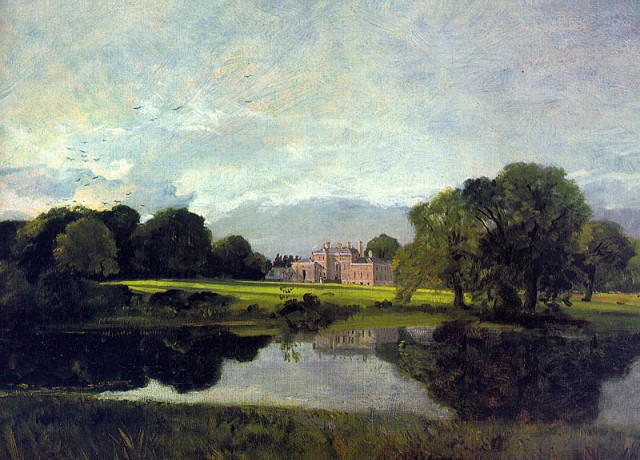In his introduction to the Sleaford family at the beginning of At Lady Molly’s, Nick evokes his image of Dogdene, the Sleaford great house: “I also knew Constable’s picture in the National Gallery, which shows the mansion itself lying away in the middle distance, a faery place set among giant trees beyond the misty water-meadows of the foreground in which the impastoed cattle browse . . . .” [ALM 13/10]
John Constable (1776-1837) was a British painter known for sweeping landscapes of his native Suffolk County, the Salsbury Plain and its famous cathedral, and views of the then-rural outskirts of London. Constable was known for his impasto, paint applied thickly so that brush strokes were visible, which was not a fashionable technique in his day. He paired painstaking attention to directly-observed detail with compositions that revealed his belief in a Nature endowed with sentiment. Hence, he is identified as a Romantic painter, akin to his contemporary J. M. W. Turner. While Constable’s work met with consistent critical esteem within his own lifetime, he struggled for commercial success and had to resort to commissioned portraits of affluent sitters in order to support his family.
Portraits of great houses were not common in Constable’s output, and the Constable Dogdene in the National Gallery is an invention of Powell’s, as is Dogdene itself. Constable favored landscapes into which picturesque cottages or humble farmsteads were nestled, rather than those surrounding pretentious mansions. Nevertheless, at least two or three paintings by Constable of Malvern Hall in Warwickshire exist, and suggest the sort of scene Nick has in mind when he remembers Dogdene. The one shown here dates from 1809 and is now in the collection of the Tate Museum.

Malvern Hall
John Constable, 1809
oil on canvas, 21 X 33 in
Tate Museum
image in public domain from Wikimedia Commons
Nick goes on to quote a (fictional) entry in the diary of the redoubtable Samuel Pepys (1633-1703), who recounts a visit to Dogdene and a typical sexual adventure there with a housekeeper in the Sleaford employ. On her way to more secluded parts of the house, “The Housekeeper was mighty civil, and showed us the Great Hall and stately Galleries, and the picture by P. Veronese that my Lord’s grandfather did bring with him out of Italy, a most rare and noble thing.” (ALM 11)
Paolo Veronese’s (1528-1588) greatest commissions were for clients throughout the Veneto, but he is most readily identified with his huge Venetian paintings of Biblical and classical mythological and historical scenes (see Alexander receiving the Children of Darius after the Battle of Issus in QU).

The Allegory of Love — Infidelity
Paolo Veronese, ~ 1570
76 X 76 inches
The National Gallery, London
image in public domain from WikiMedia Commons
Veronese took inspiration from the high Renaissance schools of both Titian and Raphael and emerged with a synthesis that is now usually dubbed Mannerism, alluding to a kind of exaggeration of qualities that take his paintings somewhere beyond the simpler naturalism that his forbears aspired to. Later in Dance [HSH 209/225] the Dogdene Veronese is identified as Iphigenia. There is not a known Veronese Iphigenia, so we show this allegory called Infidelity, which seems appropriate to the tone of ALM.
Pingback: The Barbizon School | picturesinpowell
Pingback: Portraits of Pepys | picturesinpowell
Pingback: Our Van Troost | picturesinpowell